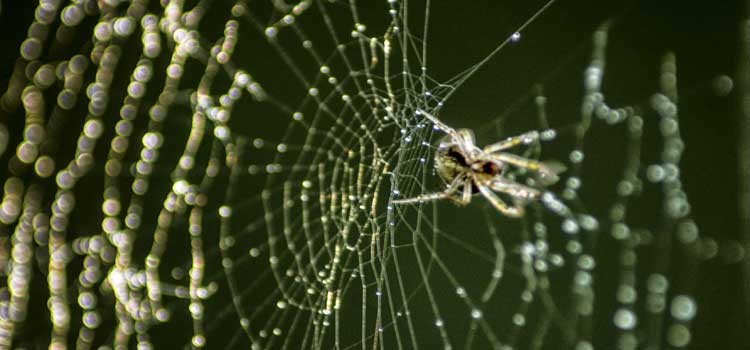Whether you call it a spider web, spiderweb, spider’s web, or cobweb (yes, they are all acceptable), all such spider web material is created by proteinaceous spider silk. This silk is expelled from spinnerets located on the hind end of your creepy-crawly friend. Spiders have existed for 100 million years, making that sticky spider web material one of nature’s oldest fibers. So while you may feel as though these webs exist only to extend your housekeeping time or to ambush you on an otherwise peaceful hike, take solace in knowing that it is not all about you. In fact, spider webs serve an array of purposes for their creators. Some use it for prey capture or reproduction, while for others it provides a nesting place and even a place to store food. As such, many spiders can produce different silks from different gland types. Some species have the capacity to produce up to eight different silk types over their lifetime. Now that’s a lot of spider web material!
What is in Spider Web Material?
Despite how fragile it appears, spider web material is some of the strongest fiber known to man. The strength of spider web material is greater than that of the same weight in steel. Not surprisingly, it has greater elasticity as well. With up to eight different types of silk, the possibilities for spider web material are seemingly endless.
Spiders create this silk using several glands in their abdomen, and it is a labor intensive process. The actual spider web material is made from fibroin and sericin proteins. Though not much is known about the actual process of spider web material creation, it is thought to have some similarities to another well-known protein, human hair.
What Makes Spider Web Material Sticky?
As it turns out, not all spider web material is sticky. Generally you will find that only the parts of the web designed to snag prey are truly sticky. A single strand of spider web is actually made up of several smaller strands resembling a rope. This spider web rope can easily become tangled making it appear sticky when in fact it is simply twisted or wrapped around a branch, your clothing, or a broom!
The stickier parts of a web require a glue-like substance or mucus that the spider secretes from yet another gland. This glue is carefully and strategically suspended on those silk threads. The glue’s sticky properties vary with the behavior and speed of the object to which it is sticking. That is to say that the faster an object moves while in contact with the glue, the stickier it becomes. So much so that can be classified as an elastic solid like rubber. When in this form, this substance is one of the most effective glues that nature has ever created.
But that is not all. In addition to being strategically sticky, spider web material is conductive, meaning that it can carry an electric charge. When an object creates a static charge, with the startled flap of an insect’s wing for instance, the silk is attracted to the object effectively causing the strands to close in on the object. Another engineering feat for the spider!
Why Do Spiders Not Stick To Their Webs?
So how do spiders avoid sticking to their own webs? Unique behaviors and biological features make it possible. First and foremost, spiders are notoriously careful and deliberate with their movements. They instinctively minimize their contact with their own webs. But when that fails, they can rely on both a chemical coating on their exterior and hair-like structures on their many legs. The chemical coating inherently resists sticking while the hair-like structures divert the sticky stuff from their bodies keeping the sticking to a minimum.
Now if only we humans and weasels could avoid the tangled, sticky mess, too. But that’s another post.
Read more about Spider Web Material at Wikipedia.

